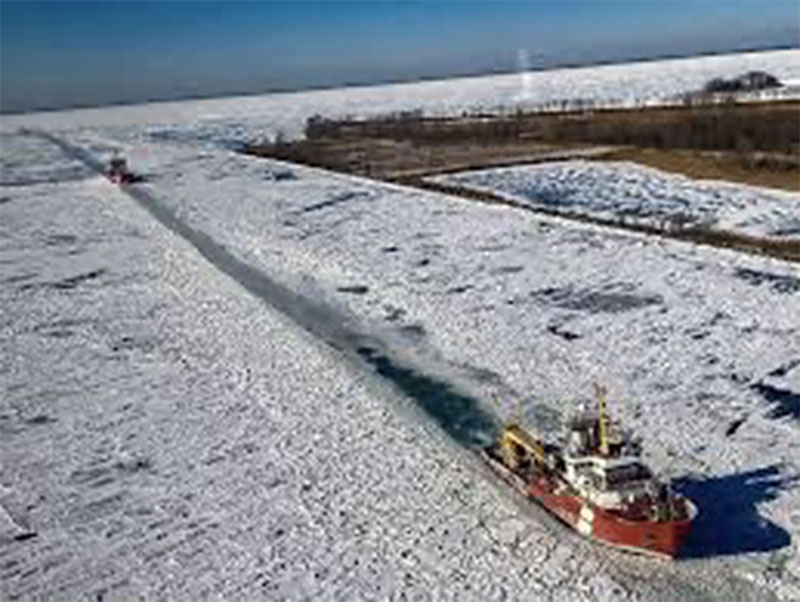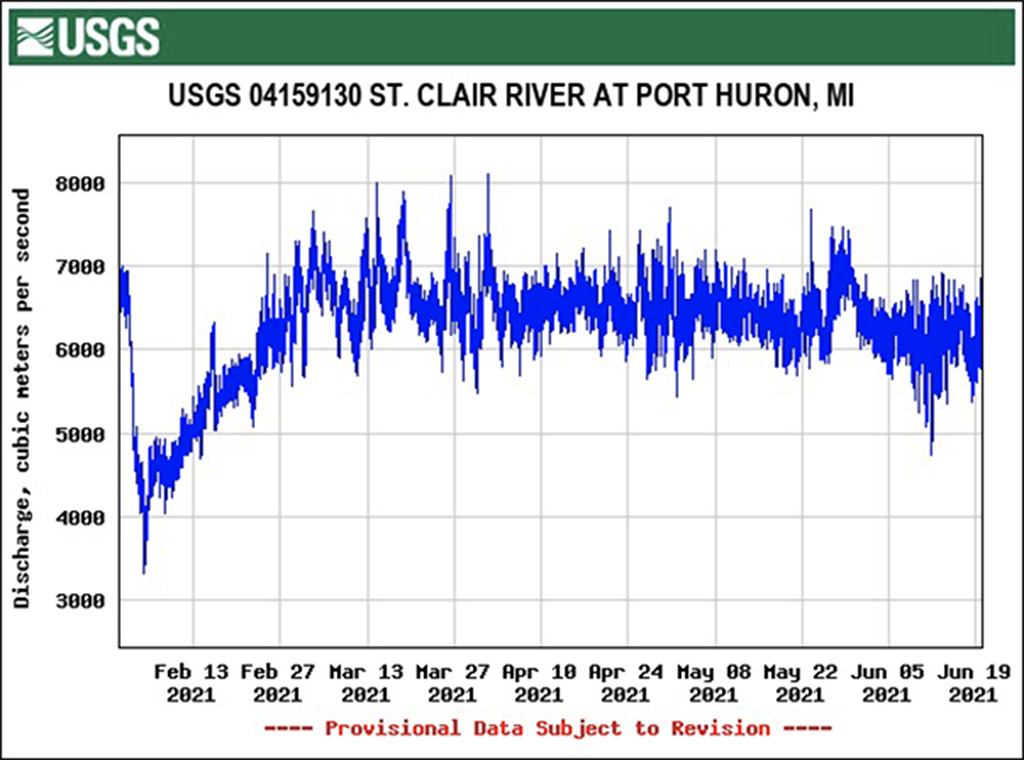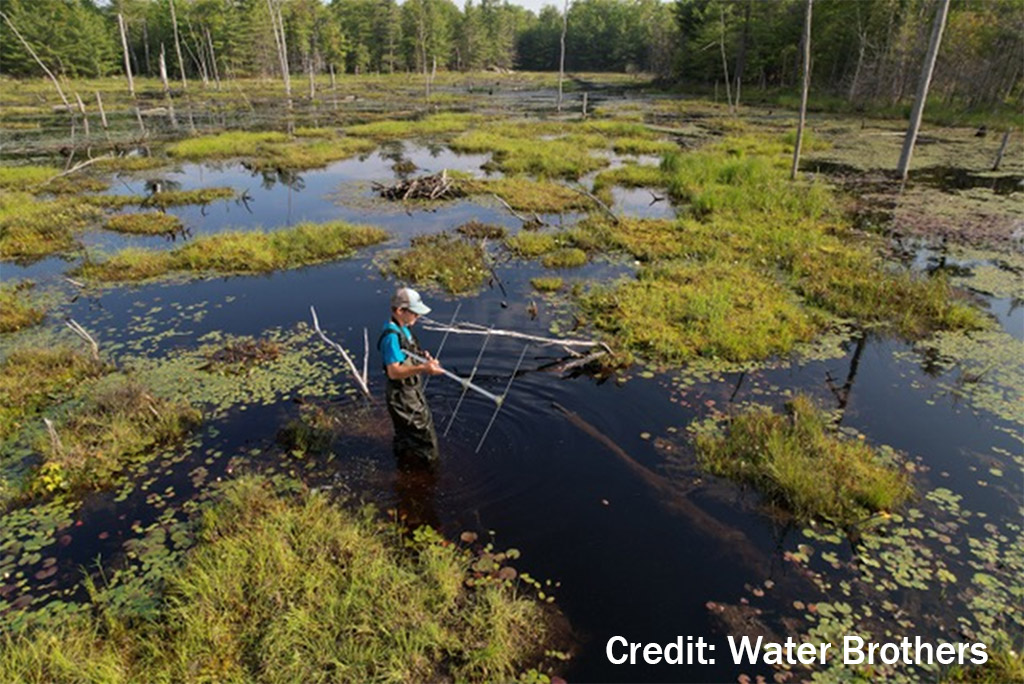June 2021 Update
Where are water levels headed?
The quick answer is down, but why?
Not just because of dry conditions around all the lakes and little ice cover that allowed increased evaporation
– there are two other very probable factors.
Last February there was a massive ice jam in the St. Clair River; consequently Canada and the US sent ice breakers up and down the river to enable cargo ships to go through. What happens in such situations? The high flows cause ice layers that are up to 8 feet thick. The fast-moving water can scour out the riverbed, deepening it. Whenever eroded sand/clay sediments fill in the river’s navigation channel, the USACE dredges it to maintain channel depth. The result – increased outflow. How much has this changed the conveyance capacity of the St. Clair River? If there is erosion, and it continues, Middle Lakes water levels could drop to close to the record low levels of 2013.
Who is watching? We are in touch with the US Army Corps Detroit offices and we are pleased that they are planning to collect new bathymetry (depth measurements) of the St. Clair River this summer. In addition, though, a 3-dimensional mathematical model of the entire river needs to be created so that the impact of changes to this critical outflow can be understood and the riverbed stabilized with the same rock rubble that was removed during the last major navigation dredging in the early 1960s.
Another disturbing situation! While the flows in the St. Clair River during the past 6 months have varied from 4,000 Cu.M./Sec to 7,000 Cu.M/Sec, the International Lake Superior Board of Control uses the fixed number of 5,225 Cu.M./Sec as an integral part of determining the flow of water from Lake Superior under Regulation Plan 2012. We must seriously ask WHY? since the USGS posts daily flows for the St. Clair River. Check out their graph below.
Bottom line: the IJC’s International Lake Superior Board of Control has a criterion “to balance both upstream and downstream interests”. However, they carefully hold Lake Superior to a 4-foot range while Lakes Michigan, Huron and Georgian Bay are allowed to swing wildly, with a new range of well over 6.5 feet.
Given the ecological and economic harm this increased range causes along the shorelines of this vast body of water, the “balancing” criterion needs to be met; there needs to be much more equitable management of our water levels. That, for instance, means using monthly averages of St. Clair River flows when determining the discharges from Lake Superior, and much better monitoring of any St. Clair River conveyance capacity changes.
McMaster U’s Prof. Pat Chow-Fraser’s Georgian Bay 2021 research is underway, with six research projects and crews working long hours on the Bay.
It turns out that SAR turtles, snakes, salamanders, and frogs all use inland vernal pool wetlands such as the large one pictured above, especially for their young, since there are no fish present to eat them. What is a vernal pool? The photo above is a good example – an inland wetland not directly connected to coastal wetlands, hence a more protected area for nursery habitat.
More McMaster U researchers pictured above.
- Prabha Rupasinghe, Post-doctoral fellow and remote-sensing and GIS specialist, is documenting how the increase in water level has changed vegetation zonation in coastal marshes of Georgian Bay;
- Danielle (Dani) Montocchio, Ph.D candidate, is studying the effects of climate change on ecosystem services of wetlands in Georgian Bay, including the recovery of vernal pools following wildfire, and response of fish and plants to rapidly increasing water levels over the past decade;
- and Nicholas Skaljin, senior thesis student, is studying the expected return of young-of-the-year muskellunge in coastal marshes of Severn Sound following increased water levels.
All of their findings will be peer reviewed and eventually be published in respected scientific journals. Once COVID restrictions are lifted, we will hold another scientific reporting symposium.
This vital research would not happen without GBGLF’s financial and logistical support. YOU can be part of this tremendous research by donating to help with the costs. If you want to be kept informed, make sure you are on our mailing list.
Heads Up! The family of the late Dr. Karl Schiefer (the well-respected aquatic biologist and ecologist) has donated his large slide library to GBGLF. We have now digitalized all the slides. Very soon we will be posting his beautiful and not so beautiful but with a message images – on our website.
MAKE YOUR IMPACT TODAY
Donations help us make a difference
because we can continue our work
and bring it to a conclusion for future generations.
We depend on private donors, foundations and sponsors like you.
Charitable donations can help reduce, or even cancel out, the tax
you would otherwise have to pay to the government.
PREFER TO DONATE BY MAIL? HERE'S HOW...
Please make out your cheque to Huronia Community Foundation
and mark in the notation line "for Georgian Bay Great Lakes Foundation" and mail it to:
Huronia Community Foundation, P.O. Box 324, Midland, Ontario, L4R 4L1
SHARE DONATIONS ARE NOW EASIER
Donate Securities to the Georgian Bay Great Lakes Foundation Fund
through the Huronia Community Foundation
To ensure that we credit the right fund, ask that donations be directed to:
Georgian Bay Great Lakes Foundation Fund
Georgian Bay Great Lakes Foundation is an Ontario registered not-for-profit
affiliated with the federally-registered charity, Huronia Community Foundation
You can get more information about claiming donations from the CRA website and your Financial Advisor.





